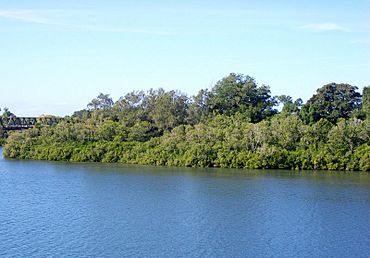Coocumbac Island Nature Reserve facts for kids
Quick facts for kids Coocumbac Island Nature ReserveNew South Wales |
|
|---|---|
|
IUCN Category IV (Habitat/Species Management Area)
|
|

Coocumbac Island, photographed from Taree
|
|
| Nearest town or city | Taree |
| Established | September 1981 |
| Area | 0.06 km2 (0.0 sq mi) |
| Managing authorities | NSW National Parks and Wildlife Service |
| Website | Coocumbac Island Nature Reserve |
| See also | Protected areas of New South Wales |
The Coocumbac Island Nature Reserve is a special protected area in New South Wales, Australia. It's a small island, about 6 hectares (the size of 15 football fields!), located in the Manning River near the town of Taree. This reserve is super important because it protects a rare type of forest called a subtropical lowland rainforest.
Sadly, most of these rainforests in Australia were cut down for farms and homes. Coocumbac Island is one of the few small patches left. The island's soil is very rich because it comes from the Manning River. This soil gets extra nutrients from rocks upstream, making it perfect for rainforest plants. The area around Taree gets a lot of rain, about 1176 mm each year.
Contents
Animals and Plants of Coocumbac Island
Island Animals
One of the most noticeable animals on Coocumbac Island is the grey-headed flying fox. These large bats can number up to five thousand at certain times of the year! You might also spot interesting birds like the osprey, which is a type of fishing hawk, and the colourful Wompoo fruit dove.
Unique Island Plants
The main type of forest on the island is known for its large fig trees and giant stinging trees. Many different kinds of fig trees grow here. The huge Moreton Bay fig trees are especially easy to spot. Other fig types include the deciduous fig, strangler fig, small leaf fig, and watery fig. The town of Taree even gets its name from a local fig tree, the sandpaper fig.
Other cool trees on the island include the stinging tree, which you should definitely not touch! There's also the native olive. The native elm grows here, which is the furthest south it naturally grows. A very large native hackberry tree stands tall on the island, reaching 30 meters high with a trunk 1.2 meters wide. Less common trees include the white walnut and the Australian rose mahogany.
To keep the rainforest healthy, people are working to help native rainforest plants grow and to remove unwanted weeds.
Mangroves Around the Island
Around the edges of Coocumbac Island, you'll find a cool community of two types of mangrove trees. These are the grey mangrove and the river mangrove. Mangroves are special trees that can grow in salty water.
What "Coocumbac" Means
The name "Coocumbac" means "meeting place" in the local Biripi language. The Biripi people are the traditional Aboriginal people of this area. They used to visit the rainforest regularly to gather food, find plants for medicine, collect fibres for making bags and nets, and hold social gatherings. The rainforest is also very important spiritually to them.


